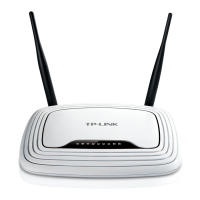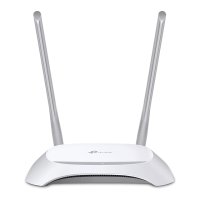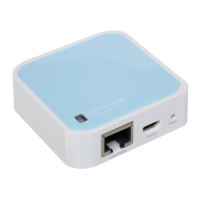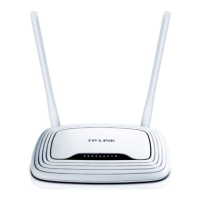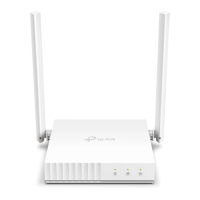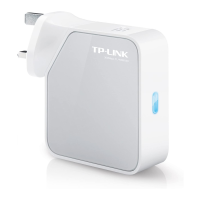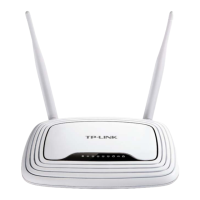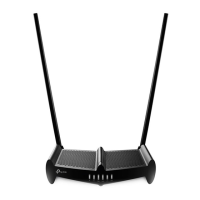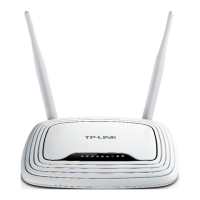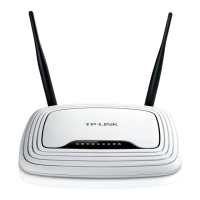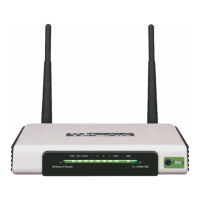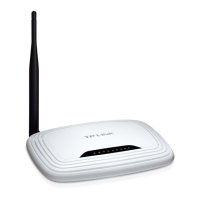Do you have a question about the TP-Link TL-WR820N and is the answer not in the manual?
Describes the router's capabilities and design for SOHO networks.
Details the router's top and back panel components and their functions.
Provides guidance on optimal router placement for security and Wi-Fi performance.
Explains Wireless Router, Access Point, Range Extender, and WISP modes for internet connection.
Step-by-step guide on accessing and logging into the router's web interface.
Setting the router's primary operational mode for network needs.
Configuring WAN, LAN, DHCP, DNS, MAC Clone, and routing settings.
Customizing Wi-Fi, guest network, schedule, WPS, and advanced wireless options.
Managing Port Forwarding, DMZ, UPnP, Firewall, Access Control, IP/MAC Binding.
Restricting internet access and content for specific users or devices.
Prioritizing network traffic for specific devices or applications.
Setting up IPv6 connectivity and status for the router.
Managing firmware, backups, passwords, logs, diagnostics, time, and LEDs.
Setting the router to work in WISP mode for wireless ISP connections.
Configuring WISP internet connection types and MAC cloning.
Customizing Wi-Fi, guest network, schedule, and WPS for WISP mode.
Implementing Port Forwarding, DMZ, UPnP, Firewall, Access Control, IP/MAC Binding.
Managing internet access and content restrictions for family members.
Setting up IPv6 connection types and status for WISP mode.
Managing firmware, backups, passwords, logs, diagnostics, time, and LEDs.
Setting the router to function as an Access Point for the network.
Configuring LAN IP address, subnet mask, and default gateway for AP mode.
Customizing Wi-Fi, guest network, schedule, and WPS for AP mode.
Updating the router's firmware to the latest version.
Backing up and restoring router configuration settings.
Managing password and local access for router administration.
Reviewing system logs for troubleshooting and monitoring.
Testing network connectivity using Ping or Tracert.
Configuring the router's time and daylight saving settings.
Manually or scheduled rebooting of the router.
Adjusting LED status and enabling Night Mode for the router.
Setting the router to function as a Range Extender for Wi-Fi coverage.
Connecting to a host network and customizing extended network settings.
Updating the router's firmware for improved performance and features.
Saving and restoring router configuration settings.
Managing password and local access for router administration.
Reviewing system logs for troubleshooting and monitoring.
Configuring the router's time and daylight saving settings.
Restarting the router manually or on a schedule.
Adjusting LED status and enabling Night Mode for the router.
Steps to retrieve or reset a forgotten wireless password.
Procedures for forgotten login passwords and accessing the web interface.
Troubleshooting steps for no internet access, including DNS and IP issues.
Resolving problems with finding or connecting to wireless networks.
Guidelines for safe usage, handling, and environmental considerations.
Describes the router's capabilities and design for SOHO networks.
Details the router's top and back panel components and their functions.
Provides guidance on optimal router placement for security and Wi-Fi performance.
Explains Wireless Router, Access Point, Range Extender, and WISP modes for internet connection.
Step-by-step guide on accessing and logging into the router's web interface.
Setting the router's primary operational mode for network needs.
Configuring WAN, LAN, DHCP, DNS, MAC Clone, and routing settings.
Customizing Wi-Fi, guest network, schedule, WPS, and advanced wireless options.
Managing Port Forwarding, DMZ, UPnP, Firewall, Access Control, IP/MAC Binding.
Restricting internet access and content for specific users or devices.
Prioritizing network traffic for specific devices or applications.
Setting up IPv6 connectivity and status for the router.
Managing firmware, backups, passwords, logs, diagnostics, time, and LEDs.
Setting the router to work in WISP mode for wireless ISP connections.
Configuring WISP internet connection types and MAC cloning.
Customizing Wi-Fi, guest network, schedule, and WPS for WISP mode.
Implementing Port Forwarding, DMZ, UPnP, Firewall, Access Control, IP/MAC Binding.
Managing internet access and content restrictions for family members.
Setting up IPv6 connection types and status for WISP mode.
Managing firmware, backups, passwords, logs, diagnostics, time, and LEDs.
Setting the router to function as an Access Point for the network.
Configuring LAN IP address, subnet mask, and default gateway for AP mode.
Customizing Wi-Fi, guest network, schedule, and WPS for AP mode.
Updating the router's firmware to the latest version.
Backing up and restoring router configuration settings.
Managing password and local access for router administration.
Reviewing system logs for troubleshooting and monitoring.
Testing network connectivity using Ping or Tracert.
Configuring the router's time and daylight saving settings.
Manually or scheduled rebooting of the router.
Adjusting LED status and enabling Night Mode for the router.
Setting the router to function as a Range Extender for Wi-Fi coverage.
Connecting to a host network and customizing extended network settings.
Updating the router's firmware for improved performance and features.
Saving and restoring router configuration settings.
Managing password and local access for router administration.
Reviewing system logs for troubleshooting and monitoring.
Configuring the router's time and daylight saving settings.
Restarting the router manually or on a schedule.
Adjusting LED status and enabling Night Mode for the router.
Steps to retrieve or reset a forgotten wireless password.
Procedures for forgotten login passwords and accessing the web interface.
Troubleshooting steps for no internet access, including DNS and IP issues.
Resolving problems with finding or connecting to wireless networks.
Guidelines for safe usage, handling, and environmental considerations.
| DSL WAN | No |
|---|---|
| Ethernet WAN | Yes |
| Wi-Fi band | Single-band (2.4 GHz) |
| Wi-Fi standards | 802.11b, 802.11g, Wi-Fi 4 (802.11n) |
| Top Wi-Fi standard | Wi-Fi 4 (802.11n) |
| WLAN data transfer rate (max) | 300 Mbit/s |
| WLAN data transfer rate (first band) | 11 Mbit/s |
| WLAN data transfer rate (second band) | 54 Mbit/s |
| Cabling technology | 10/100Base-T(X) |
| Networking standards | IEEE 802.11b, IEEE 802.11g, IEEE 802.11n |
| Ethernet LAN data rates | 10, 100 Mbit/s |
| Ethernet LAN interface type | Fast Ethernet |
| Ethernet LAN (RJ-45) ports | 3 |
| Security algorithms | WEP, WPA, WPA2, WPA2-PSK |
| Media access protocol | Access Control, Local Management, Remote Management |
| Antenna gain level (max) | 5 dBi |
| Product type | Tabletop router |
| Product color | White |
| LED indicators | Activity, LAN, WLAN |
| Certification | CE, RoHS |
| Output current | 0.6 A |
| Output voltage | 5 V |
| Power source type | DC |
| Storage temperature (T-T) | -40 - 70 °C |
| Operating temperature (T-T) | 0 - 40 °C |
| Storage relative humidity (H-H) | 5 - 90 % |
| Operating relative humidity (H-H) | 10 - 90 % |
| Number of products included | 1 pc(s) |
| Cables included | LAN (RJ-45) |
| Windows operating systems supported | Windows 10, Windows 2000, Windows 7, Windows 8, Windows 8.1, Windows 98SE, Windows NT, Windows Vista, Windows XP |
| Depth | 114 mm |
|---|---|
| Width | 154 mm |
| Height | 36 mm |
